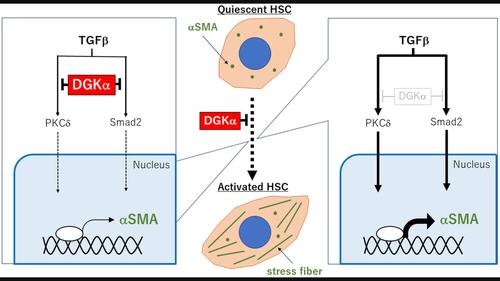当前位置:
X-MOL 学术
›
FEBS Open Bio
›
论文详情
Our official English website, www.x-mol.net, welcomes your feedback! (Note: you will need to create a separate account there.)
Ablation of DGKα facilitates α-smooth muscle actin expression via the Smad and PKCδ signaling pathways during the acute phase of CCl4-induced hepatic injury
FEBS Open Bio ( IF 2.6 ) Pub Date : 2023-12-17 , DOI: 10.1002/2211-5463.13749 Keiko Seino 1 , Tomoyuki Nakano 1 , Toshiaki Tanaka 1 , Yasukazu Hozumi 2 , Matthew K. Topham 3 , Kaoru Goto 1 , Ken Iseki 4
FEBS Open Bio ( IF 2.6 ) Pub Date : 2023-12-17 , DOI: 10.1002/2211-5463.13749 Keiko Seino 1 , Tomoyuki Nakano 1 , Toshiaki Tanaka 1 , Yasukazu Hozumi 2 , Matthew K. Topham 3 , Kaoru Goto 1 , Ken Iseki 4
Affiliation

|
Expression of α-smooth muscle actin (αSMA) is constitutive in vascular smooth muscle cells, but is induced in nonmuscle cells such as hepatic stellate cells (HSCs). HSCs play important roles in both physiological homeostasis and pathological response. HSC activation is characterized by αSMA expression, which is regulated by the TGFβ-induced Smad pathway. Recently, protein kinase C (PKC) was identified to regulate αSMA expression. Diacylglycerol kinase (DGK) metabolizes a second-messenger DG, thereby controlling components of DG-mediated signaling, such as PKC. In the present study we aimed to investigate the putative role of DGKα in αSMA expression. Use of a cellular model indicated that the DGK inhibitor R59949 promotes αSMA expression and PKCδ phosphorylation. It also facilitates Smad2 phosphorylation after 30 min of TGFβ stimulation. Furthermore, immunocytochemical analysis revealed that DGK inhibitor pretreatment without TGFβ stimulation engenders αSMA expression in a granular pattern, whereas DGK inhibitor pretreatment plus TGFβ stimulation significantly induces αSMA incorporation in stress fibers. Through animal model experiments, we observed that DGKα-knockout mice exhibit increased expression of αSMA in the liver after 48 h of carbon tetrachloride injection, together with enhanced phosphorylation levels of Smad2 and PKCδ. Together, these findings suggest that DGKα negatively regulates αSMA expression by acting on the Smad and PKCδ signaling pathways, which differentially regulate stress fiber incorporation and protein expression of αSMA, respectively.
中文翻译:

在 CCl4 诱导的肝损伤急性期,DGKα 的消除通过 Smad 和 PKCδ 信号通路促进 α-平滑肌肌动蛋白的表达
α-平滑肌肌动蛋白 (αSMA) 的表达是血管平滑肌细胞的组成型表达,但在肝星状细胞 (HSC) 等非肌肉细胞中被诱导表达。 HSC 在生理稳态和病理反应中发挥着重要作用。 HSC 激活的特点是 αSMA 表达,该表达受 TGFβ 诱导的 Smad 通路调节。最近,蛋白激酶 C (PKC) 被确定可调节 αSMA 表达。二酰甘油激酶 (DGK) 代谢第二信使 DG,从而控制 DG 介导的信号传导成分,例如 PKC。在本研究中,我们旨在研究 DGKα 在 αSMA 表达中的假定作用。细胞模型的使用表明,DGK 抑制剂 R59949 促进 αSMA 表达和 PKCδ 磷酸化。在 TGFβ 刺激 30 分钟后,它还能促进 Smad2 磷酸化。此外,免疫细胞化学分析表明,没有 TGFβ 刺激的 DGK 抑制剂预处理会导致 αSMA 呈颗粒状表达,而 DGK 抑制剂预处理加 TGFβ 刺激显着诱导 αSMA 掺入应力纤维中。通过动物模型实验,我们观察到DGKα敲除小鼠在注射四氯化碳48小时后肝脏中αSMA表达增加,同时Smad2和PKCδ磷酸化水平增强。总之,这些发现表明,DGKα 通过作用于 Smad 和 PKCδ 信号通路来负向调节 αSMA 表达,这两个信号通路分别差异调节应力纤维掺入和 αSMA 蛋白表达。
更新日期:2023-12-17
中文翻译:

在 CCl4 诱导的肝损伤急性期,DGKα 的消除通过 Smad 和 PKCδ 信号通路促进 α-平滑肌肌动蛋白的表达
α-平滑肌肌动蛋白 (αSMA) 的表达是血管平滑肌细胞的组成型表达,但在肝星状细胞 (HSC) 等非肌肉细胞中被诱导表达。 HSC 在生理稳态和病理反应中发挥着重要作用。 HSC 激活的特点是 αSMA 表达,该表达受 TGFβ 诱导的 Smad 通路调节。最近,蛋白激酶 C (PKC) 被确定可调节 αSMA 表达。二酰甘油激酶 (DGK) 代谢第二信使 DG,从而控制 DG 介导的信号传导成分,例如 PKC。在本研究中,我们旨在研究 DGKα 在 αSMA 表达中的假定作用。细胞模型的使用表明,DGK 抑制剂 R59949 促进 αSMA 表达和 PKCδ 磷酸化。在 TGFβ 刺激 30 分钟后,它还能促进 Smad2 磷酸化。此外,免疫细胞化学分析表明,没有 TGFβ 刺激的 DGK 抑制剂预处理会导致 αSMA 呈颗粒状表达,而 DGK 抑制剂预处理加 TGFβ 刺激显着诱导 αSMA 掺入应力纤维中。通过动物模型实验,我们观察到DGKα敲除小鼠在注射四氯化碳48小时后肝脏中αSMA表达增加,同时Smad2和PKCδ磷酸化水平增强。总之,这些发现表明,DGKα 通过作用于 Smad 和 PKCδ 信号通路来负向调节 αSMA 表达,这两个信号通路分别差异调节应力纤维掺入和 αSMA 蛋白表达。



























 京公网安备 11010802027423号
京公网安备 11010802027423号